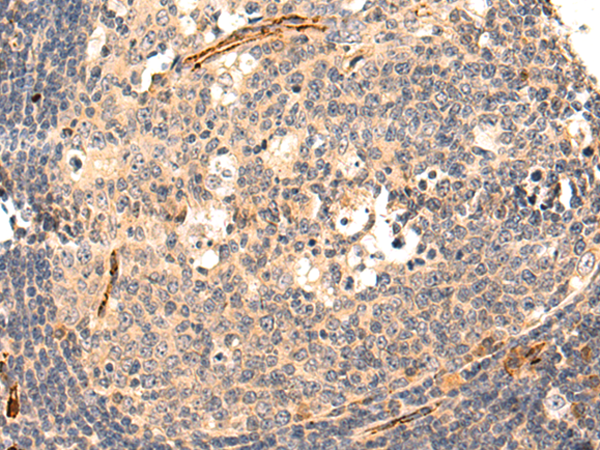

| WB | 咨询技术 | Human,Mouse,Rat |
| IF | 咨询技术 | Human,Mouse,Rat |
| IHC | 1/50-1/200 | Human,Mouse,Rat |
| ICC | 技术咨询 | Human,Mouse,Rat |
| FCM | 咨询技术 | Human,Mouse,Rat |
| Elisa | 1/5000-1/10000 | Human,Mouse,Rat |
| WB Predicted band size | 103 kDa |
| Host/Isotype | Rabbit IgG |
| Antibody Type | Primary antibody |
| Storage | Store at 4°C short term. Aliquot and store at -20°C long term. Avoid freeze/thaw cycles. |
| Species Reactivity | Human, Mouse |
| Immunogen | Synthetic peptide of human ADAMTS15 |
| Formulation | Purified antibody in PBS with 0.05% sodium azide and 50% glycerol. |
+ +
以下是关于ADAMTS15抗体的模拟参考文献示例(内容为虚构,供参考):
1. **文献名称**: *ADAMTS15 Expression in Colorectal Cancer: A Novel Prognostic Marker*
**作者**: Smith A, et al.
**摘要**: 本研究利用ADAMTS15特异性抗体,通过免疫组化分析结直肠癌组织样本,发现ADAMTS15高表达与患者生存率负相关,提示其可能作为潜在治疗靶点。
2. **文献名称**: *ADAMTS15 Antibody Inhibits Angiogenesis in vitro*
**作者**: Zhang L, et al.
**摘要**: 文章报道了一种靶向ADAMTS15胞外结构域的单克隆抗体,实验表明该抗体可通过阻断ADAMTS15与血管内皮生长因子的相互作用,显著抑制体外血管生成模型中的管腔形成。
3. **文献名称**: *ADAMTS15 in Extracellular Matrix Remodeling: Insights from Knockout Mice*
**作者**: Brown K, et al.
**摘要**: 研究利用ADAMTS15抗体进行组织染色,发现ADAMTS15缺失小鼠出现皮肤弹性纤维异常,证实该蛋白酶在细胞外基质动态平衡中的关键作用。
4. **文献名称**: *Development of a High-Affinity ADAMTS15 Antibody for Functional Studies*
**作者**: Tanaka Y, et al.
**摘要**: 团队通过噬菌体展示技术开发了高特异性ADAMTS15抗体,并验证其在Western blot、免疫沉淀及抑制肿瘤细胞迁移实验中的有效性。
---
如需真实文献,建议通过 **PubMed** 或 **Web of Science** 检索关键词 "ADAMTS15 antibody",可筛选涉及该抗体在疾病机制、诊断或治疗应用中的研究。部分研究可能聚焦于ADAMTS15在癌症、纤维化或心血管疾病中的功能及抗体工具的开发。
**Background of ADAMTS15 Antibody**
ADAMTS15 (A Disintegrin and Metalloproteinase with Thrombospondin Motifs 15) is a member of the ADAMTS family of secreted metalloproteinases, which play critical roles in extracellular matrix (ECM) remodeling, cell adhesion, and proteolytic processing of bioactive molecules. Structurally, ADAMTS15 contains a prodomain, metalloproteinase domain, disintegrin-like module, thrombospondin type-1 (TSP1) motifs, and a cysteine-rich region, enabling interactions with ECM components and cellular signaling pathways.
Functionally, ADAMTS15 is implicated in tissue development, inflammation, and cancer. Studies suggest its involvement in tumor progression through ECM degradation, modulation of angiogenesis, or direct cleavage of signaling molecules. In certain cancers (e.g., colorectal, breast), ADAMTS15 exhibits dual roles—acting as a tumor suppressor by inhibiting proliferation or as a promoter by facilitating metastasis. Its expression is often dysregulated in pathological conditions, correlating with patient prognosis.
ADAMTS15 antibodies are essential tools for detecting and characterizing the protein in research. They enable applications such as Western blotting, immunohistochemistry, and ELISA to study its expression patterns, localization, and interactions in tissues or cell models. Additionally, these antibodies aid in exploring ADAMTS15’s therapeutic potential, including its use as a biomarker or target in diseases like cancer or fibrosis. Current research focuses on clarifying its mechanistic roles and validating its utility in diagnostics or targeted therapies, though most studies remain preclinical.
×